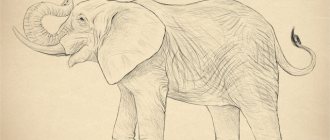Tiger is the largest representative of felines, one of the largest and most powerful predators. A few centuries ago, these felines lived over a vast territory; today they are found in Indochina and India, the Far East and Primorye. Cats live in bamboo thickets, swampy areas, dense forests, rocky hills and taiga.
Where do tigers live, how much does a tiger weigh on average, what is a tiger's habitat, how wild cats reproduce, what they eat, what lifestyle they prefer - read our article.
Origin story
Carl Linnaeus was the first to make a scientific description of the animal in his work Systema naturæ. The scientist described a large representative of the cat family under the name Felis tigris. The famous Russian naturalist Nikolai Severtsov described an animal called Tigris striatus in 1858. British zoologist George Gray described a striped king of the jungle called Tigris regalis in 1867. In 1929, scientists assigned the tiger to the genus Panthera.
Data regarding the development of the species were obtained from the analysis of remains and studies in the field of molecular phylogenetics. Scientists have found that the species comes from eastern Asia, in particular from northern China and the island of Java. The size of the ancestors of modern tigers was somewhere between the dimensions of Indian leopards and the subspecies of the tiger living in the Sunda archipelago.
The animal remains that were found in the Jetis strata in Java are dated to be between 1.66 and 1.81 million years old. It follows from this that approximately 2 million years ago, striped animals were common in the eastern regions of Asia, living on the islands of Borneo and Palawan.
It was previously believed that wild cats appeared in the territory of modern northern China, but recent research indicates a wider range of their habitat.
Small-sized individuals existed in Japan and on the island. Sakhalin. Scientists explain this phenomenon by insular dwarfism.
Cats later spread from eastern Asia to India. There is a hypothesis that the animals inhabited the island of Kalimantan, on whose territory the fangs of ancient tigers were found. For example, paleontologists recently found the top of a tooth in Nia Cave, which is located on the Malaysian part of the island of Sarawak.
Interesting things on the site:
Where does a puma live and what does it look like?
Cat breeds similar to a tiger
Types of tigers
Scientists identify several subspecies of the tiger, three of which have already disappeared from the face of the Earth due to irrational human activity:
- Panthera tigris tigris from Asia;
- Panthera tigris altaica, also known as the Amur, Ussuri, North China, Manchurian or Siberian tiger. The habitat of cats is the Amur Region, Jewish Autonomous Okrug, Primorsky and Khabarovsk Territories, northeastern China, a small territory of North Korea;
- Panthera tigris tigris or Bengal lives in Pakistan, India, Bangladesh, Nepal, Bhutan, Myanmar;
- Panthera tigris corbetti or Indochinese (another name is Corbet's tiger). Animals inhabit the territory of Cambodia, Myanmar, southern China, Laos, Thailand, Malaysia and Vietnam;
- Panthera tigris jacksoni or Malayan is found only in the southern part of the Malay Peninsula;
- Panthera tigris amoyensis or the Chinese tiger lives in Southern China and is endangered. Naturalists say the last Chinese tiger living in the wild was killed in 1994. According to the latest data, about 50 individuals live in captivity;
- Panthera tigris sumatrae or Sumatran lives exclusively on the Indonesian island. Sumatra. The population size in the wild is no more than 500 individuals;
- Panthera tigris balica or Balinese is an extinct subspecies that previously lived on the island. Bali and was exterminated by hunters in 1937;
- Panthera tigris virgata or Transcaucasian is an extinct subspecies. According to some sources, the last tiger was seen in 1968;
- Panthera tigris sondaica or Javanese lived on the island. Java disappeared from the face of the Earth in the 80s of the twentieth century.
Amur tiger
Lifestyle of a Lone Hunter
Depending on its habitat, the color of tiger fur varies from bright orange to straw yellow with the inevitable black stripes. The tiger looks great in its luxurious striped skin! This seemingly flashy outfit perfectly hides the tiger in bamboo thickets and tall grass. Each tiger wears a one-of-a-kind fur coat: the pattern on the tiger skin, like human fingerprints, is never repeated.
Tigers are very strong and powerful animals, capable of killing large prey with one blow. Nature arranges it in such a way that everything about tigers is adapted for hunting:
- The tiger finds its prey thanks to its exceptionally fine hearing. When attacking, he straightens his ears and points them forward, and when defending, he pulls them back. Vibrissae help to navigate the terrain;
- tiger eyes see well in the dark, their night vision is six times better than that of humans;
- powerful jaws and huge fangs, which can grow up to 7 cm in length, help the tiger deal with prey, which is sometimes larger than itself; the large skull increases the bite force of the upper jaw;
- the long flexible body and muscular pelvic limbs give the tiger speed, mobility and power, and the long tail helps maintain balance during long jumps;
- Like almost all cats, tigers can retract their sickle-shaped claws into their pads. When hunting, claws are formidable weapons.
Tigers live as hermits, occupying a certain area of the forest. The animals mark their hunting grounds, the area of which sometimes exceeds 1 thousand km2, with deep scratches on tree trunks, and leave odorous marks on stones and bushes. Walking around his property, the owner regularly checks his own and others’ marks and mercilessly drives away competitors - other males.
The favorite habitats of tigers are impassable thickets along the banks of reservoirs, because these mighty animals, unlike most representatives of the cat kingdom, are excellent swimmers, and swimming gives them real pleasure. Tigers living in the tropics, in hot weather after swimming, look for a shady place under the trees or hide in a cool cave. Tigers avoid open spaces.
The tiger prefers to hunt alone. Its activity peaks at dawn and dusk. Tireless on long journeys, and in search of prey it can travel up to 20 kilometers in a day. Like all cats, it locates its prey using hearing. Having noticed an animal, he bends down and silently sneaks in the tall grass until he overtakes the victim with one powerful jump, and he can jump forward up to 10 meters and 5 meters up. Sharp claws dig into the victim's back, fangs bite through her throat. It knocks large prey to the ground with a blow of its paw and crushes vertebrae with its fangs. The main objects of tiger hunting are ungulates: buffaloes, deer, wild pigs.
While protecting its territory, the Amur tiger can also attack a bear, although such a fight does not always end in victory for the tiger, and Bengal tigers sometimes attack even adult elephants and rhinoceroses.
The tiger usually drags the prey, no matter how large, to its hiding place, often several hundred meters away, so that it can dine there quietly to its own pleasure. Each tiger consumes about three tons of food per year, but it never kills more than it can eat, unlike, for example, wolves.
Appearance
Many people know what a tiger looks like. Mainland cats are more impressive in size compared to the “islanders”. For example, the largest tigers - Bengal and Amur - weigh 180-280 kg, some individuals reach 300 kg. Body length varies from 1.5 to 3 m. Tail length is 90-100 cm. Height at withers is 60-110 cm. Average life expectancy in the wild is 25 years. The photo of the animal perfectly demonstrates the full power of this beast. The average weight of a tiger is 220 kg
The body is elongated, massive, flexible with pronounced muscles. The front part of the body is larger than the back; the cat's shoulder girdle is located above the sacrum. The long luxurious tail is evenly covered with hair. The front paws have five toes, the hind paws have four. The claws are hooked and retracted.
The facial part is protruding, the forehead is convex, the head is round, the skull is large and massive, the cheekbones are expressive. White vibrissae are arranged in five rows.
The eyes are slanted, the iris is amber, the pupils are round.
The dentition consists of 30 teeth. On the upper and lower jaws there are six incisors and two canines up to 8 cm long.
The coat is of moderate length, sparse, dense in the “southerners”, high and fluffy in the “northerners”. The main color is rusty red, rusty brown, the belly, back of the ears, chest and inner surface of the paws are much lighter. Stripes - brown or black. Along the body and neck the stripes are located transversely and vertically. They go down the sides and onto the stomach.
The lower ends of the stripes are sharp, sometimes forked. On the back of the body the stripes are more dense. The pattern from the sacrum goes to the back of the thighs.
Reference. Tigers have well-developed night vision and partially color vision. Due to the special structure of the vocal cords, animals emit a terrifying roar, but they voice only during the period of sexual hunting.
Sumatran tiger
Color mutations
Tigers are characterized by a mutation in coat color. It is for this reason that tigers are often born with white fur, which, however, does not mean that they are albinos. After all, their fur, although white, is covered with black stripes, and their eye color is blue or amber, which is typical for tigers with a normal color.
flickr/sypix
In addition, their non-albino status can be judged by the presence of melanin, the amount of which is not large, but is still present, which cannot be said about albinos. The birth of white tigers at one time or another can occur in each subspecies. But if one of the parents was of the Amur subspecies, then the baby has a better chance of being born white. In addition to white tigers, tigers with an even more exotic golden color are also found in nature. The coat of this subspecies is light with brown stripes.
flickr/Tambako the Jaguar
The white areas of the fur are larger in size than those of tigers of other subspecies. The golden tiger is common not only among purebred Bengal tigers; it can often be found among those in whose veins the blood of the Amur subspecies flows.
What do they eat?
What does a tiger eat in the wild? Their main food is ungulates: red and sika deer, wild boar and nilgai, roe deer, black-backed tapirs. Sometimes the animals hunt large herbivores - Indian buffalo, gaur and elk. Periodically, wild cats feed on monkeys, pheasants, hares, reptiles and large fish. The cat eats the carcass of a killed animal for several days. At one time, a tiger can eat up to 50 kg of meat.
There is a known case where a tiger killed an adult Indian rhinoceros. Sometimes cats attack dogs, cows, horses and donkeys. Cats eat nuts, grass and fruits in the summer.
Description
The Amur tiger (also known as the Ussuri tiger) is the largest tiger on the planet and is an endangered species. The weight of a large mammal can exceed 300 kilograms. Some sources report males weighing up to 390 kg, although such large individuals are not found now. Body length is 160-290 cm, tail - 110 cm. The Ussuri tiger is an adornment of the Far Eastern taiga and an object of worship for many peoples of the Far East. This beautiful, exotically colored cat, unrivaled in strength and power in the entire world fauna, is depicted on the flag and coat of arms of the Primorsky Territory, as well as on many heraldic symbols of cities and regions of the region. The history of the species indicates that the tiger is an easily vulnerable animal, despite its large size and enormous physical strength, and it is such that it can drag a horse carcass on the ground for more than 500 m, is capable of reaching speeds of up to 80 km/h in the snow, speed second only to the cheetah.
The only subspecies that has a five-centimeter layer of fat on its belly, protecting it from freezing winds at extremely low temperatures. The body is elongated, flexible, the head is round, the legs are short, and the tail is long. The ears are very short, as it lives in cold areas. The tiger distinguishes colors. At night he sees five times better than a human. According to modern data, this wild cat belongs to the largest subspecies. Its coat is thicker than that of its relatives living in warm areas, and its color is lighter. The main coat color in winter is orange, the belly is white.
Where he lives - habitat
The largest population of Amur tigers is located in a protected area in the southeast of Russia, along the banks of the Amur and Ussuri rivers in the Khabarovsk and Primorsky territories. About 10% (40-50 individuals) of the population lives in China (Manchuria). Ussuri tigers are also common in the foothills of the Sikhote-Alin in the Lazovsky district of Primorsky Krai, where every sixth predator lives in a relatively small area.
Best articles: Drug Clamoxil: treatment of infectious diseases in cats
How does the Amur tiger live and what does it eat?
The Ussuri tiger is the ruler of vast territories, the area of which for the female is 300-500 km², and for the male - 600-800 km². If there is enough food within its territory, the animal does not leave its territory. With a shortage of game, the number of cases of tigers attacking large livestock and dogs increases. The predator is active at night. Males lead a solitary life, while females are often found in groups. Greeting each other occurs with special sounds produced by energetic exhalation of air through the nose and mouth. Signs of expression of friendliness also include touching heads, muzzles, and even rubbing sides.
Despite its enormous strength and developed senses, the tiger has to devote a lot of time to hunting, since only one out of 10 attempts is successful. He crawls towards his victim, moving in a special way: arching his back and resting his hind legs on the ground. It kills small animals by gnawing their throats, and first knocks large ones to the ground and only then gnaws off the cervical vertebrae.
If the attempt fails, then the owner of the taiga moves away from the potential victim, since he rarely attacks again. The predator usually drags the killed prey to the water, and before going to bed hides the remains of the meal. He often has to drive away competitors. He eats his prey lying down, holding it with his paws.
Tigers usually hunt large ungulates, but on occasion they also do not disdain fish, frogs, birds, mice, and even eat plant fruits. The diet is based on wapiti, sika and red deer, roe deer, wild boar, elk, lynx, and small mammals. The daily norm for an average individual is 9-10 kg of meat. For the prosperous existence of one tiger, about 50-70 ungulates per year are needed.
Despite the widespread belief about cannibalism, the Amur tiger almost never attacks humans and rarely enters populated areas. Since the 1950s, in the Primorsky and Khabarovsk territories, only about a dozen attempts to attack people have been recorded within populated areas. In the taiga, attacks even on pursuing hunters are quite rare.
https://youtube.com/watch?v=0svgKkFJk60
Lifestyle and habits
Tigers are loners by nature. They contact their relatives when the mating season begins.
Ussuri go out hunting day and night. They lie in wait for their prey from a secluded place, suddenly jump on their backs and gnaw through the vertebrae. The victim's carcass can be moved several kilometers. If the jump is unsuccessful, the cat gives chase, but no further than 150 m. During the hunt, the tiger does not make the slightest sound.
For humans, the tiger is the most dangerous predator. If you believe statistics, then over the entire period of its life, a tiger can take the lives of more than 500 people. Often these representatives of the cat family become cannibals due to a lack of regular food. Fortunately, such reports about tigers do not come very often.
The largest and smallest “cat” on the planet
Tigers are capable of living not only on the continent. There are representatives of this species who have chosen the nature of the island of Sumatra and the Malay Peninsula as their habitat. They differ from their relatives primarily in body size. The maximum weight that an adult can reach is 120-130 kilograms. Sumatran tigers are considered the smallest among their other relatives.
And the Amur tiger is considered the largest cat on the planet. Where does this subspecies of the cat family, which is also called Ussuri or Far Eastern, live? We'll tell you now!
Reproduction and offspring
Tigers are characterized by polygamy. The mating season occurs in December-January. In areas with a minimal prevalence of tigers, there is one male per female. On lands where there are more cats, males start fights for the right to own the “lady of the heart.”
The tigress is capable of fertilization 3-4 days a year, during this period the pair mates several times a day.
Most tigresses give birth for the first time at the age of 3-4 years, giving birth once every 2-3 years. The duration of pregnancy is 98-114 days.
To set up a den, females choose hard-to-reach places: rocky crevices, caves, windbreaks, reed supports.
Babies appear in March-April. Usually there are 3-4 kittens in the litter, less often 5-6. Babies open their eyes after 6-8 days. For the first 1.5 months, the cubs eat milk, and after 8 weeks the mother allows them to leave the den. Kittens become independent at the age of 18 months, but finally leave the tigress at 2-3 years, less often at 5 years. Males do not take part in raising children.
First, the female looks after the matured cubs, since they live near the den. Then the young males go off in search of their own territory. Usually they have to win space from other males. The strongest wins!
Enemies
Striped animals have few natural enemies among animals. The cat is at the top of the food pyramid, so it has almost no competitors. Sometimes a tiger has to confront packs of Indian red wolves.
Brown and Himalayan bears periodically take prey from tigers, for which they receive a well-deserved punishment. Another potentially dangerous predator is the crocodile, with which the wild cat periodically has clashes.
The most terrible enemy of these giants is man, who, over centuries of his destructive activity, has brought this species of wild cats to the brink of extinction.
Interesting facts about tigers
We have collected for you some interesting facts about tigers:
- The tiger is the main character of eastern myths, in which he is described as the king of animals, the ruler of all inhabitants of the land.
- The main symbol with which this striped giant is associated is military valor and courage. The cat was perceived as a mediator between Heaven and Earth.
- Tiger was chosen as the mascot of the 1988 Summer Olympics in Seoul.
- Koreans use objects with the image of a tiger as amulets.
- In China, the cat is considered a symbol of health and strength. The Chinese believe that it wards off evil spirits.
- In Chinese Buddhism, the animal represents anger, greed and insatiable lust.
- This wild cat is included in the Chinese twelve-year calendar, where it occupies third place.
- Some peoples of India called themselves “tiger people”. In such regions, hunting tigers was prohibited.
- In ancient mythology, the image of this beast was used less frequently. In the myth of Ovid, Thetis turns into a tigress in order to avoid marriage with Peleus. In Greek mythology, tigers replaced leopards when they pulled the chariot of Dionysus.
- In Western culture, the image is used in the art of tattooing. For example, in a criminal environment it denotes strength, anger, cruelty.
- Researchers discovered the first works of painting depicting a wild cat on Korean tombs, which date back to the period 37 BC. e. — 668 n. e. In addition, his image was often used in Chinese painting.
- In Indian art, the most famous example is a mechanized and painted Tipu Sultan eating an English soldier.
- In Central Asia, despite the fact that Islam prohibits depicting living creatures on shrines, an exception was made - tigers were depicted on fabrics, carpets, and mosque facades.
- The image was also used in European painting. An example of this is the African hunting scene by Delacroix and in Rubens’s painting “The Hunt for Tigers and Lions,” dated 1618.
- The power of the beast, its justice and wisdom are glorified in poetry and prose.
- Rudyard Kipling in The Jungle Book showed this striped beauty as treacherous and cruel. Alan Milne, in the story about Winnie the Pooh, portrayed Tigger as a funny and cheerful jumper.
- Borges at one time published a collection of poems, “The Gold of Tigers.” William Blake's poem "The Tiger" has become a textbook.
- Fritz Lang's film The Bengal Tiger features a man-eating tiger.
- In the cartoon Kung Fu Panda, Angelina Jolie herself speaks in the voice of Tigress.
- In the cartoon “Aladdin”, Jasmine’s pet tiger, Raja, lives in Jasmine’s chambers.
- In the third part of the cartoon "Madagascar" a minor character appears - a circus tiger named Vitaly.
- The famous Soviet film "Striped Voyage" tells the story of a group of tigers that break out of their cages and go on a rampage on a ship.
- One of the main characters of the cartoon “On the Road with the Clouds” is a good-natured tiger cub.
- In the Marvel comics there is a character named Tigger.
- The striped giant starred in the movie “Scarface” with Al Pacino.
- The image of a wild cat is also used in pop music. For example, ABBA sang a song called Tiger.
- The third part of Rocky features the song Eye of the Tiger performed by the band Survivor.
- In the movie Life of Pi, the hero is left alone in a boat with a tiger.
Who is stronger: a lion or a tiger?
Naturalist John Varty spent a long time observing the lives of tigers and lions in the wild and described cases where cats chewed through the shell of a large leopard tortoise, while lions did not succeed. He also argued that in a duel between a lion and a tiger, the striped predator would always win.
The same opinion is shared by employees of the SCT Foundation, who care for Chinese tigers. Experts say that tigers are larger and more powerful than lions. The Bengal subtype is highly likely to defeat the African lion if given the opportunity.
Nevertheless, the tiger was not called the King of Beasts, since it does not lead a royal lifestyle, but rather a robber one. He chases wild boars and deer through the forest, has no subjects, and leads a solitary life.
Where do tigers live in the wild?
The tiger is an Asian predator. Currently, isolated populations of the animal live in the south, southeast and east of the Asian continent. There are no tigers on the African continent.
Where do they live?
The tiger's habitat is tropical forests, semi-deserts, swampy areas, rocky hills, foothills and mountainous areas overgrown with vegetation, and taiga. Tigers are not picky about living conditions and quickly adapt to almost any terrain.
To make a den, animals look for steep cliffs with caves, niches under overhanging stones, and secluded thickets of bushes or reeds.
PUMA











